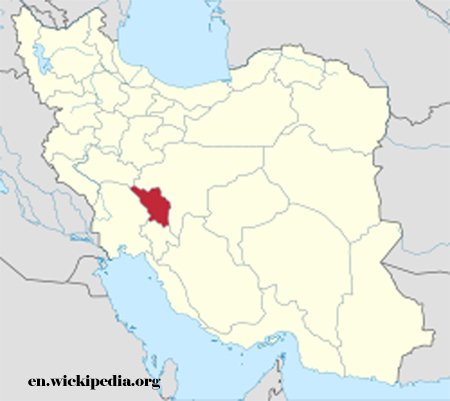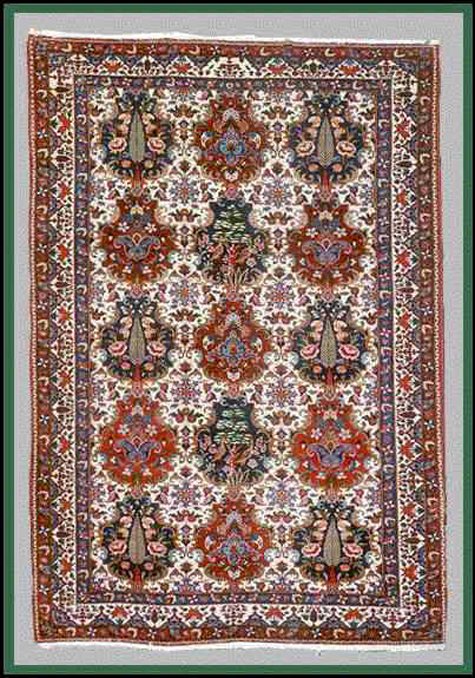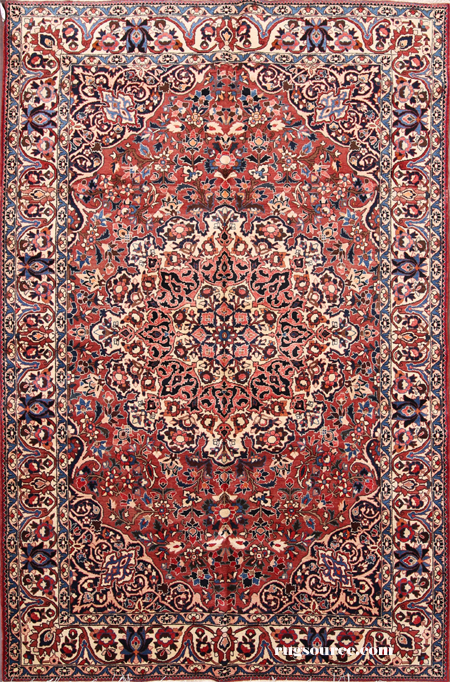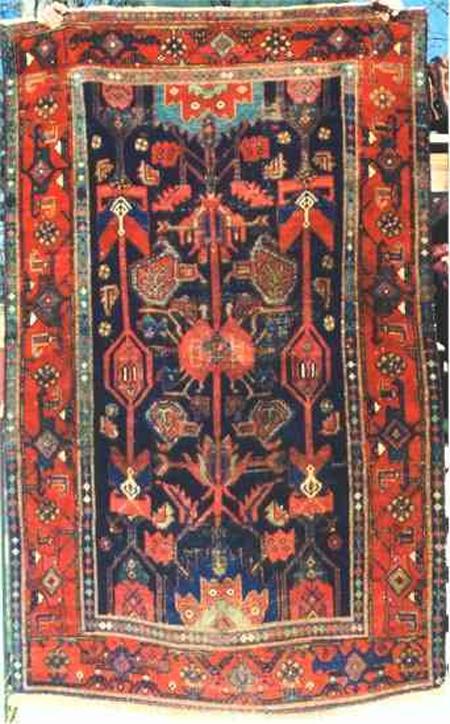BAKHTIARI ORIENTAL RUGS
BAKHTIARI
HISTORY
Bakhtiari oriental rugs woven before 1950 were examples of tribal rugs, which are traditionally smaller rugs with wool yarns hand knotted onto a wool foundation. The nomadic lifestyle of these sheep herding tribes, moving their stock from winter to summer pasture, dictated the necessity of smaller and easily movable looms, using the wool from their sheep for the foundation and pile of their rugs.
Sometime in the middle of the last century, these nomadic tribes
began to settle in various villages in Western Iran. Weaving looms that did not have to
be seasonally moved
could be larger and sturdier, making the production of larger size
rugs possible.
The use of cotton for the foundation of the rugs also became more and
more common. Baktiari rugs woven today use wool pile knotted on cotton foundations.
BAKHTIARI ORIENTAL RUGS
WEAVING LOCATION TODAY
The Bakhtiari oriental rugs of today are woven in a large number of villages located in an area of Western Iran known as Chahar Mahal.
It must be noted the weavers of Bakhtiari oriental rugs are typically not of Bakhtiari tribes, but rather a number of tribes under the rule of Bakhtiaris. The rugs coming from this region are all referred to as Bakhtiari rugs.The rugs produced by these formerly nomadic tribes share common designs, structures, and color palettes.
Often, place names are used to refer to the origin of the pattern and the quality of the rug, rather than to the place of actual manufacture. As an example, Saman, Hori, Chahal Shotur and Bibibaff are names used to refer to certain Bakhtiari rugs.
The Bibibaff have a high knot density and are considered one of the best, whereas the Hori are of looser weave and inferior quality. The Chahal Shotur and Saman rugs are considered to be of lower quality than the Bibibaff but are of good quality nonetheless.
Generally speaking, Bakhtiari rugs are made of very good wool with the knots thoroughly beaten down to make the rugs thick and solid. They are considered to be one of the most durable and long-lasting of Persian rugs.
BAKHTIARI
DESIGN
Bakhtiari oriental rugs have 2 predominant designs:
1. Garden Panel Design (Khesti)
This is the most common design with individual squares (sometimes rectangular, diamond, or hexagonal) decorated with animals and plants. Each compartment will have a different (and complementary to the others) color. The motifs include trees such as the willow and the cypress, grapevines, vases, and birds, etc. Direct influences from the designs of the nearby Persian Isfahan rugs include tree-of-life motifs as well.
2. Medallion and Corner Design
This is the second most common design, very similar to the Heriz, but typically with more subdued colors. This type can also consist of an overall lattice with repeated diamonds. Though floral motifs may be featured, these are still considered to be more geometric, rather than curvilinear design elements.
BAKHTIARI
CONSTRUCTION
Most Bakhtiari oriental rugs are single-wefted, though double-wefted can be found. These rugs have plain fringe at both ends and a thick single cord overcast with dark brown wool or other color on the sides.
Wefts are the side-to-side rows of the foundation. After a row of knots has been tied horizontally on the warp (up and down) cords, one or more weft threads are them inserted across on top of the knots. The weft cord or cords will then be beaten down by the weaver across the loom on top of each row of knots to secure them.
The knot is typically symmetrical, also called the Turkish or Ghiordes knot. A yarn is placed in a loop around each of 2 warp cords, forming a knot which opens in the middle. The symmetrical knot is often used for thicker rugs because it provides a stronger consistency. The pile (knots) is wool.
As mentioned above, the foundation (warps and wefts) of older rugs was wool, while newer ones are cotton (and sometimes dyed blue).
The sizes are usually 4x6 to 10x14 though oversized ones can occasionally be found. The colors come from natural dyes.
THE BAKHTIARI
A VERY UNIQUE ORIENTAL RUG
The combination of the nomadic tribal design containing abstract geometric motifs symbolizing the Persian garden, and the urban village design of classical sophisticated Persian motifs makes the Bakhtiari rug a very unique Persian oriental rug.
The weavers have perfected a blend of the 2 types of design, imbibing their product with their own individual creativity. Add to that, the combination of excellent quality wool and rich, naturally dyed colors, and it is not surprising the Bakhtiari rugs, especially antique ones, are sought after world-wide.
Bakhtiari patterns are well-recognized and copied in other weaving centers in Iran, as well as those in Pakistan, India, and China.
Top of Bakhtiari Oriental Rugs
"The Cleanest Clean You've Ever Seen."
by
ABC Oriental Rug & Carpet Cleaning Co.
130 Cecil Malone Drive Ithaca, NY 14850
607-272-1566
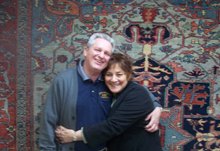
Ken and Harriet Adams
Owners of ABC
130 Cecil Malone Drive Ithaca, NY 14850
For directions, Click Here.
OPEN:
Mon through Thur-8am to 5pm, Fri-8am to 4:30pm
Weekends-Saturdays-10am to 1pm
ABC Oriental Rug is on Facebook!
We regularly post tips and information about your carpet, rugs, upholstery, and tile and grout so please visit us often.
We update our Facebook page with our latest discounts and we are also offering exclusive promotions to our Facebook fans. These are limited and short notice promotions.
When you like our page, you will also be able to claim your special gift from us!
"Like Us"
on Facebook
and find out
what's going on!

ABC
Carpet & Rug
Spotting Guide
Did you know that our ABC Responsible Care Spotter can get those pesky spots out of your carpet and will work equally as well on your clothes and upholstery?
Stop by our office and pick one up. They are $5.00 + Tax but if you have carpets or upholstery cleaned in your home or business, just request a free one from your Technician.
And don't forget to fill out the form above to download your free ABC Spotting Guide!


